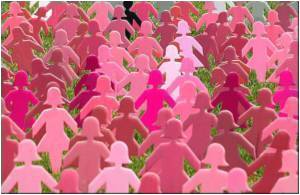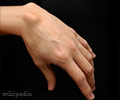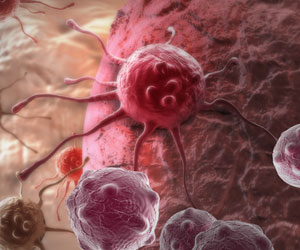Cells which properly organize themselves into communities live long and prosper, but disorganized cells can become cancerous.

Mark LaBarge, a cell and molecular biologist in Berkeley Lab’s Life Sciences Division, and Mina Bissell, a Berkeley Lab Distinguished Scientist also with the Life Sciences Division, carried out a unique study of normal human mammary epithelial cells that had been enriched into pools of the two principal lineages that make up breast tissue – the milk-producing luminals and the myoepithelials that blanket them. In healthy breast tissue, these two lineages organize themselves into an ordered bi-layer. To observe and quantify changes in the distribution of these cell lines with respect to one another over time, LaBarge, Bissell and a team of collaborators used a unique “micropatterning” technique, in which the cells were confined to a three-dimensional cylindrical geometry.
“We demonstrated that while bi-layered organization in mammary epithelium is driven mainly by the lineage-specific differential expression of the E-cadherin adhesion protein, the expression of the P-cadherin adhesion protein makes additional contributions that are specific to the organization of the myoepithelial layer,” LaBarge says. “Disruption of these adherens junction proteins or the actomyosin network that supports them either prevented the formation of the bi-layer, or caused a loss of pre-formed bi-layers. This is the first reported evidence that the two principle lineages of adult human mammary gland possess intrinsic and reversible characteristics that guide their organization into a bi-layer.”
Throughout a person’s life, the various tissues in his or her body will be replenished and repaired by drawing upon a reservoir of adult stem cells. As new cells replace old ones or are used to construct new tissue, the architecture of that specific tissue must be maintained. Otherwise, cancer or other diseases can arise. This process requires that lineage-specific progenitor cells or their differentiated progeny be able to reach their ultimate destination within the tissue. This task is particularly daunting for breast cell lineages because the mammary gland undergoes cyclical changes in its architectural structure, showing as much as a 10-fold expansion in preparation for lactation followed by return to normal size. During these cycles, the precise bi-layered branching organization throughout the gland, in which a layer of secretory luminal epithelial cells (LEPs) is surrounded by a layer of contractile myoepithelial cells (MEPs), must be maintained.
“We hypothesized that mammary epithelial cells possess lineage-specific intrinsic abilities to self-organize into domains of lineage specificity, which would help explain how, for instance, the mammary stem cell-enriched zone in the ducts is maintained separately from the rank-and-file LEPs and MEPs, and how LEPs and MEPs form and maintain bi-layers,” LaBarge says. “The phenomenon of self-organization has not been well studied in humans, perhaps because of the challenges of working with primary materials and a paucity of tractable culture systems for maintaining cell types from normal adult tissues.”
Initially, LaBarge, Bissell and their collaborators used a classical self-organization assay, in which heterogeneous aggregates of dissociated cells from embryonic tissues were cultured on non-adherent agarose-coated surfaces, to observe organization amongst cells divided into low and high cadherin expression groups. While somewhat effective, there was a “tremendous variation” in the size and shape of the aggregations of cells that, among other factors, made watching the same cells over time “out of the question,” according to LaBarge. To meet this challenge, he and his colleagues engineered a microwell culture platform that could confine mixtures of human mammary epithelial cells to a 3D cylindrical geometry.
Advertisement
In addition to the micropatterned assays, LaBarge and Bissell also made use of a cell culture system invented by Martha Stampfer and Jim Garbe, both with Berkeley Lab’s Life Sciences Division. This unique cell culture system made it possible for LaBarge and Bissell to carry out their study using normal human adult epithelia.
Advertisement
LaBarge says the discovery of the important roles played by E-cadherin and P-cadherin proteins in the organization of human LEPs and MEPs into a bi-layer was a major surprise.
“For the formation of the breast tissue bi-layer, the LEP and MEP progenitor cells need a way to get instructions, or else the differentiated LEP and MEP cells need to find their correct home,” he says. “Modulation of LEP and MEP activity seems to get the cells to where they ultimately need to be, but, as other studies have suggested, there is clearly much more to maintaining a breast tissue bi-layer than just adherens like LEP and MEP.”
LaBarge and Bissell reported these findings in a paper published in the Proceedings of the National Academy of Science. The paper was titled “Self-organization is a dynamic and lineage-intrinsic property of mammary epithelial cells.” Co-authoring this paper were Lea Chanson, Douglas Brownfield, James Garbe, Irene Kuhn and Martha Stampfer.
Source-Medindia









